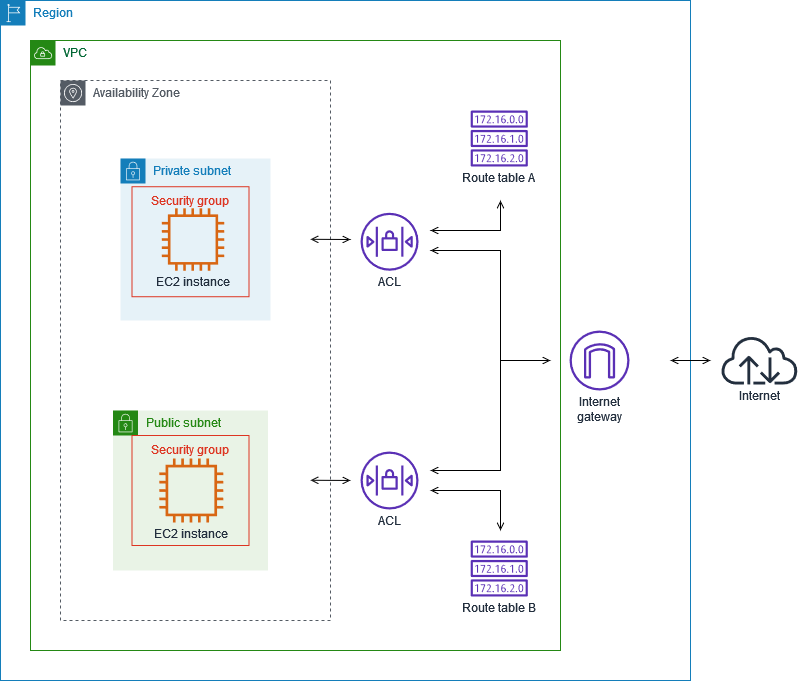Infrastructure security in Amazon VPC
As a managed service, Amazon Virtual Private Cloud is protected by Amazon global network security. For information about Amazon security services and how Amazon protects infrastructure, see Amazon Cloud Security
You use Amazon published API calls to access Amazon VPC through the network. Clients must support the following:
-
Transport Layer Security (TLS). We require TLS 1.2 and recommend TLS 1.3.
-
Cipher suites with perfect forward secrecy (PFS) such as DHE (Ephemeral Diffie-Hellman) or ECDHE (Elliptic Curve Ephemeral Diffie-Hellman). Most modern systems such as Java 7 and later support these modes.
Additionally, requests must be signed by using an access key ID and a secret access key that is associated with an IAM principal. Or you can use the Amazon Security Token Service (Amazon STS) to generate temporary security credentials to sign requests.
Network isolation
A virtual private cloud (VPC) is a virtual network in your own logically isolated area in the Amazon Cloud. Use separate VPCs to isolate infrastructure by workload or organizational entity.
A subnet is a range of IP addresses in a VPC. When you launch an instance, you launch it into a subnet in your VPC. Use subnets to isolate the tiers of your application (for example, web, application, and database) within a single VPC. Use private subnets for your instances if they should not be accessed directly from the internet.
You can use Amazon PrivateLink to enable resources in your VPC to connect to Amazon Web Services using private IP addresses, as if those services were hosted directly in your VPC. Therefore, you do not need to use an internet gateway or NAT device to access Amazon Web Services.
Control network traffic
Consider the following options for controlling network traffic to the resources in your VPC, such as EC2 instances:
Use security groups as the primary mechanism for controlling network access to your VPCs. When necessary, use network ACLs to provide stateless, coarse-grain network control. Security groups are more versatile than network ACLs, due to their ability to perform stateful packet filtering and create rules that reference other security groups. Network ACLs can be effective as a secondary control (for example, to deny a specific subset of traffic) or as high-level subnet guard rails. Also, because network ACLs apply to an entire subnet, they can be used as defense-in-depth in case an instance is ever launched without the correct security group.
Use private subnets for your instances if they should not be accessed directly from the internet. Use a bastion host or NAT gateway for internet access from instances in private subnets.
Configure subnet route tables with the minimum network routes to support your connectivity requirements.
Consider using additional security groups or network interfaces to control and audit Amazon EC2 instance management traffic separately from regular application traffic. Therefore, you can implement special IAM policies for change control, making it easier to audit changes to security group rules or automated rule-verification scripts. Multiple network interfaces also provide additional options for controlling network traffic, including the ability to create host-based routing policies or leverage different VPC subnet routing rules based on an network interfaces assigned to a subnet.
-
Use Amazon Virtual Private Network or Amazon Direct Connect to establish private connections from your remote networks to your VPCs. For more information, see Network-to-Amazon VPC connectivity options.
-
Use VPC Flow Logs to monitor the traffic that reaches your instances.
-
Use Amazon Security Hub
to check for unintended network accessibility from your instances. -
Use Amazon Network Firewall to protect the subnets in your VPC from common network threats.
Compare security groups and network ACLs
The following table summarizes the basic differences between security groups and network ACLs.
| Security group | Network ACL |
|---|---|
| Operates at the instance level | Operates at the subnet level |
| Applies to an instance only if it is associated with the instance | Applies to all instances deployed in the associated subnet (providing an additional layer of defense if security group rules are too permissive) |
| Supports allow rules only | Supports allow rules and deny rules |
| Evaluates all rules before deciding whether to allow traffic | Evaluates rules in order, starting with the lowest numbered rule, when deciding whether to allow traffic |
| Stateful: Return traffic is allowed, regardless of the rules | Stateless: Return traffic must be explicitly allowed by the rules |
The following diagram illustrates the layers of security provided by security groups and network ACLs. For example, traffic from an internet gateway is routed to the appropriate subnet using the routes in the routing table. The rules of the network ACL that is associated with the subnet control which traffic is allowed to the subnet. The rules of the security group that is associated with an instance control which traffic is allowed to the instance.

You can secure your instances using only security groups. However, you can add network ACLs as an additional layer of defense. For more information, see Example: Control access to instances in a subnet.